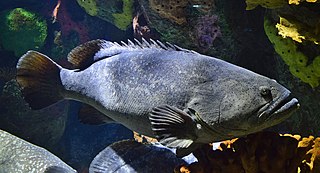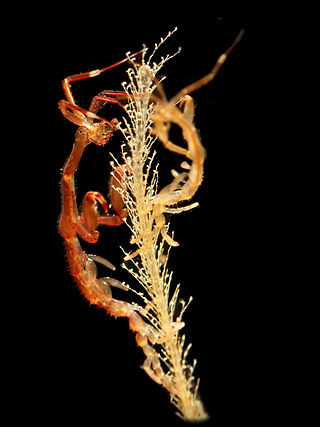Related Research Articles

Lysmata amboinensis is an omnivorous shrimp species known by several common names including the Pacific cleaner shrimp. It is considered a cleaner shrimp as eating parasites and dead tissue from fish makes up a large part of its diet. The species is a natural part of the coral reef ecosystem and is widespread across the tropics typically living at depths of 5–40 metres (16–131 ft).

The giant grouper (Epinephelus lanceolatus), also known as the Queensland groper (grouper), brindle grouper or mottled-brown sea bass, is a species of marine ray-finned fish, a grouper from the subfamily Epinephelinae which is part of the family Serranidae, which also includes the anthias and sea basses. It has a wide Indo-Pacific distribution and is one of the largest extant species of bony fish.

Perrin's beaked whale is part of the toothed whale suborder and is one of over 90 known cetaceans in existence today. Beaked whales are part of the family Ziphiidae, which are the second most diverse group out of all marine mammals with over 20 species currently recognized. Although diverse, little is understood about these timid, deep divers that can dive for up to two hours. The whales are partially named after their beak shaped jaw, which extends from their small head. The genus name Mesoplodon comes from the Greek meanings of meso- (middle), - hopla (arms), - odon (teeth), and may be translated as 'armed with a tooth in the center of the jaw'.

Caprellidae is a family of amphipods commonly known as skeleton shrimps. Their common name denotes the threadlike slender body which allows them to virtually disappear among the fine filaments of seaweed, hydroids and bryozoans. They are sometimes also known as ghost shrimps.

The leopard shark is a species of houndshark, in the family Triakidae. It is found along the Pacific coast of North America, from the U.S. state of Oregon to Mazatlán in Mexico. Typically measuring 1.2–1.5 m (3.9–4.9 ft) long, this slender-bodied shark is immediately identifiable by the striking pattern of black saddle-like markings and large spots over its back, from which it derives its common name. Large schools of leopard sharks are a common sight in bays and estuaries, swimming over sandy or muddy flats or rock-strewn areas near kelp beds and reefs. They are most common near the coast, in water less than 4 m (13 ft) deep.

The horn shark is a species of bullhead shark, in the family Heterodontidae. It is endemic to the coastal waters off the western coast of North America, from California to the Gulf of California. Young sharks are segregated spatially from the adults, with the former preferring deeper sandy flats and the latter preferring shallower rocky reefs or algal beds. A small species typically measuring 1 m (3.3 ft) in length, the horn shark can be recognized by a short, blunt head with ridges over its eyes, two high dorsal fins with large spines, and a brown or gray coloration with many small dark spots.

Syncaris pacifica is an endangered species of freshwater shrimp in the family Atyidae that occurs only in a limited range within the northern San Francisco Bay Area, California, USA. Specifically, this species occurs only in 17 stream segments within Sonoma, Napa and Marin Counties. This species is often translucent to transparent, with both sexes capable of considerable coloration altering, as a sophisticated form of camouflage. This decapod is commonly known as California freshwater shrimp, and is the only extant decapod shrimp in California that occurs in non-saline waters.

Ancylomenes magnificus, also known as the magnificent anemone shrimp, is a species of cleaner shrimp common to the Western Pacific Ocean at depths of 3–29 metres (10–95 ft). They are commonly found on stony coral, Catalaphyllia and the sea anemone, Dofleinia armata.

Sponge reefs are reefs produced by sea sponges. All modern sponge reefs are formed by hexactinellid sponges, which have a skeleton made of silica, and are often referred to as glass sponges. Such reefs are now very rare, and found only in waters off the coast of British Columbia, Washington and southern Alaska. Recently sponge reefs were identified within the strait of Georgia and Howe sound close to Vancouver. Although common in the late Jurassic period, reef-building sponges were believed to have gone extinct during or shortly after the Cretaceous period, until the existing reefs were discovered in Queen Charlotte sound in 1987–1988 – hence these sometimes being dubbed living fossils.

Cephalopholis miniata, also known as the coral grouper, coral hind, coral rock cod, coral cod, coral trout, round-tailed trout or vermillion seabass is a species of marine ray-finned fish, a grouper from the subfamily Epinephelinae which is in the family Serranidae which also includes the anthias and sea basses. It is associated with coral reefs and occurs in the Indo-Pacific.

The sixbar wrasse or six-banded wrasse is a species of wrasse in the family Labridae, native to the Indian Ocean and the western Pacific Ocean. It is an inhabitant of reef environments at depths from the surface down to 15 m (50 ft). This species can grow to 20 cm (8 in) in total length, though most individuals do not exceed 15 cm (6 in). It is of minor importance to local commercial fisheries and can also be found in the aquarium trade.

Orectolobus reticulatus, the network wobbegong, is a recently described species of carpet shark found in relatively shallow waters off Kimberley and Darwin in north-western Australia. With a known maximum length of only 52.3 centimetres (20.6 in), it may be the smallest species of wobbegong. Until its description in 2008, it had been confused with the northern wobbegong. The network wobbegong has a short snout, broad head, elongated body, and two dorsal fins, with the first being slightly larger than the second. Its body is grayish brown with darker brown markings and a pale yellow underbelly. The network wobbegong lives in shallow waters along reefy bottoms.

Hymenocera picta, commonly known as the harlequin shrimp, is a species of saltwater shrimp found at coral reefs in the tropical Indian and Pacific Oceans. It is usually considered the only species in the genus Hymenocera, but some split it into two species: H. picta from the central and east Pacific, where the spots are deep pinkish-purple with a yellow edge, and H. elegans from the Indian Ocean and west Pacific, where the spots are more brownish and have a blue edge. They reach about 5 cm (2.0 in) in length, live in pairs, and feed exclusively on starfish, including crown-of-thorns starfish. They do seem to prefer smaller, more sedentary starfish, but as these generally are not sufficiently numerous for their needs, they commonly attack crown-of-thorns starfish, both reducing its consumption of coral while under attack, and killing it within a few days.

Porites lobata, known by the common name lobe coral, is a species of stony coral in the family Poritidae. It is found growing on coral reefs in tropical parts of the Indian and Pacific Oceans.

Caprella mutica, commonly known as the Japanese skeleton shrimp, is a species of skeleton shrimp. They are relatively large caprellids, reaching a maximum length of 50 mm (2.0 in). They are sexually dimorphic, with the males usually being much larger than the females. They are characterized by their "hairy" first and second thoracic segments and the rows of spines on their bodies. Body color ranges from green to red to blue, depending on the environment. They are omnivorous highly adaptable opportunistic feeders. In turn, they provide a valuable food source for fish, crabs, and other larger predators. They are usually found in dense colonies attached to submerged man-made structures, floating seaweed, and other organisms.

Leptogorgia hebes, commonly known as the regal sea fan or false sea fan, is a species of soft coral in the family Gorgoniidae. It was formerly included in the genus Lophogorgia but that genus has been dismantled.

Saron marmoratus, commonly known as the marbled shrimp, is a species of cleaner shrimp in the family Hippolytidae. It is found in the Indo-Pacific region but in 2013 it was also found off the coast of Lebanon, probably having reached the Mediterranean by Lessepsian migration through the Suez Canal from the Red Sea. It is a popular species in aquaria due to its easy care.

The larger Pacific striped octopus (LPSO), or Harlequin octopus, is a species of octopus known for its intelligence and gregarious nature. The species was first documented in the 1970s and, being fairly new to scientific observation, has yet to be scientifically described. Because of this, LPSO has no official scientific name. Unlike other octopus species which are normally solitary, the LPSO has been reported as forming groups of up to 40 individuals. While most octopuses are cannibalistic and have to exercise extreme caution while mating, these octopuses mate with their ventral sides touching, pressing their beaks and suckers together in an intimate embrace. The LPSO has presented many behaviors that differ from most species of octopus, including intimate mating behaviors, formation of social communities, unusual hunting behavior, and the ability to reproduce multiple times throughout their life. The LPSO has been found to favor the tropical waters of the Eastern Pacific.

Regalecus russelii, or Russell's oarfish, is a species of oarfish in the family Regalecidae. It is a broadly-distributed marine fish, found in waters in the bathypelagic zone. R. russelii is a scaleless, elongate and ribbonlike fish, growing up to 8 meters in length.

Actinopyga caerulea, the blue sea cucumber, is a species of sea cucumber in the family Holothuriidae. It is native to the tropical Western Indo-Pacific region and is harvested for food.
References
- 1 2 3 4 James Vincent (November 25, 2014). "New species of terrifying looking 'skeleton shrimp' discovered" . The Independent. Archived from the original on 2022-06-14. Retrieved May 28, 2014.
- 1 2 3 4 Beck Oskin (November 19, 2013). "New Cave-Dwelling 'Shrimp' Discovered in California". Live Science. Retrieved May 28, 2014.
- ↑ Lawrence LeBlond (May 22, 2014). "Rich Biodiversity Of Species Makes Annual Top Ten List Of Discoveries". Red Orbit. Retrieved May 22, 2014.